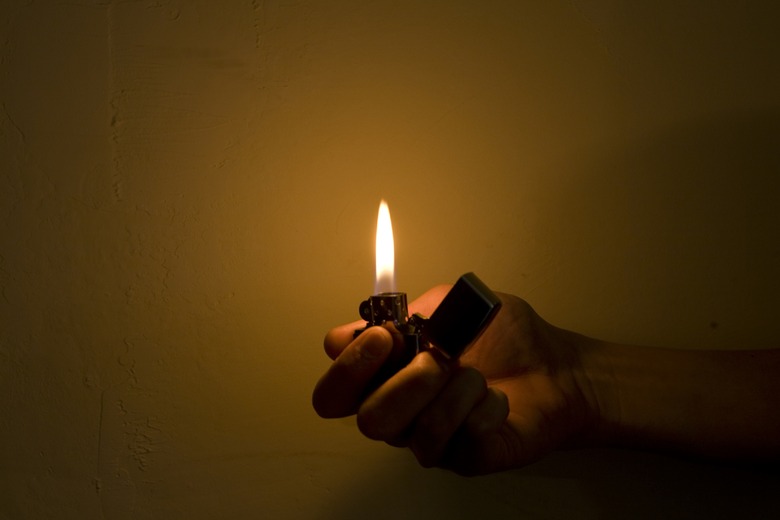How To Get Colored Lighter Flames
When you watch a fireworks show, the spectacular bursts in the sky are the result of special chemicals burning and giving off bright colors. Chemists use a very similar process in the laboratory called the "flame test," where a chemical sample is burned and the flame color compared to a chart of known chemicals. You can create your own colored flames with a common cigarette lighter and a set of the right chemical compounds.
How It Works
How It Works
There are two important parts to creating colored flame: high temperatures and the behavior of atoms. In fireworks, strong chemical reactions produce temperatures reaching between 1,700 and 2,000 degrees Celsius (3,090 to 3,630 degrees Fahrenheit). The flame of a butane cigarette lighter reaches temperatures as high as 1,970 degrees Celsius (3,580 degree Fahrenheit) — hot enough to produce the desired colors, although in relatively small amounts. Once the substances are heated, the electrons in their atoms release energy in the form of colored light.
The Chemicals
The Chemicals
The chemicals used to produce colored flames are salts of metals such as sodium or strontium. In some cases, metals by themselves, such as copper and iron, also produce bright colors. Examples of metallic salts include strontium chloride, barium chloride and lithium carbonate. The chemicals are fairly common and can be found at nearly any chemical supply dealer. Some science suppliers, especially those that sell to teachers, offer them prepackaged for making colored flames. Some camping stores and fireplace dealers also carry prepackaged kits.
Colored Lighter Flames
Colored Lighter Flames
To see colored flames, soak strips of paper in the solution. After drying, burn the strips with a lighter flame. Exercise caution with this activity: conduct the experiment on a flameproof surface and make sure there are no flammable materials nearby. Some enterprising companies, such as Extremely Ingenious Engineering, LLC, are developing solutions that can be filled into refillable lighters that will turn the flames different colors using the same principles.
Other Kinds of Fire
Other Kinds of Fire
You can obtain kits of chemicals that turn wood campfires and home fireplace fires into dazzling displays. According to the EPA, wood fires reach temperatures of 1,100 to 1,500 degrees Celsius; this is not quite as hot as a butane flame, but is still capable of producing colorful results with some chemical compounds, such as sodium chloride (table salt) and copper sulfate.
Cite This Article
MLA
Papiewski, John. "How To Get Colored Lighter Flames" sciencing.com, https://www.sciencing.com/colored-lighter-flames-8550189/. 24 April 2017.
APA
Papiewski, John. (2017, April 24). How To Get Colored Lighter Flames. sciencing.com. Retrieved from https://www.sciencing.com/colored-lighter-flames-8550189/
Chicago
Papiewski, John. How To Get Colored Lighter Flames last modified August 30, 2022. https://www.sciencing.com/colored-lighter-flames-8550189/
